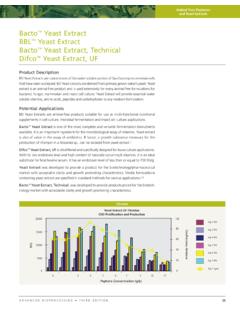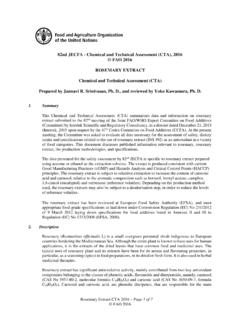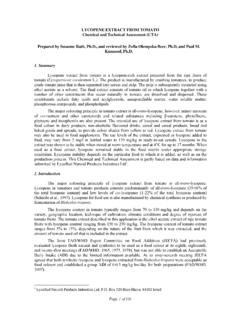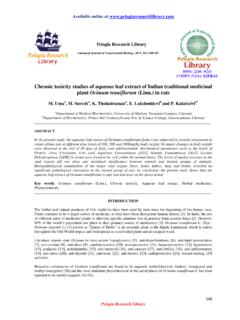Transcription of Mineral rights ownership – what is it and why is it so ...
1 Mineral rights ownership what is it and why is it so unique in the USA?IntroductionThis document is designed to explain the concept of Mineral rights ownership , and how such ownership differs between the USA and the rest of the world. Further, we will explain why this difference drives much of the oil and gas activity in the rights ownership what is it? Mineral rights ownership refers to who owns the rights to extract minerals that is, oil, gas, gold, coal and other metals and minerals from lands located in that country. This ownership is very important, since the rights confer considerable potential for profit from the extraction of these virtually all countries around the world, the owner of the surface land be it a house or farmland has absolutely no rights with regards to Mineral ownership . Indeed, it is the central governments or monarchs who own such rights . For example, in the United Kingdom, the Queen in theory owns all the rights to extract minerals from all lands in the country, including those lands located offshore.
2 In practice, of course, this ownership is actually governed by the central the USA, however, the owner of the surface land can ALSO have the rights to extract minerals from underneath that land. In other words, private individuals own much of the Mineral rights across the USA, as opposed to governmental or state does the oil industry get to obtain the ability to extract oil and gas from lands in these countries?Typically, governments will section their lands into discrete areas, commonly referred to as licenses. Governments will then offer such licenses, on a regular basis, to oil companies, on certain terms that will allow such oil firms to begin exploration and eventual development and extraction of any oil and gas located under the lands. The terms offered by governments vary considerably worldwide, but typically they include the following elements: a commitment by the oil company to conduct certain operations such as scientific analysis and the drilling of test wells.
3 Sometimes this commitment can actually be a specified amount of money. in return for the above commitment, an oil company receives a multiple year right to conduct oil exploration activities on the license often this duration is 5 or even 10 years. if oil or gas is discovered in commercial quantities, then the oil company is obliged to submit to the appropriate government authorities a development plan for that oil or gas field. This plan includes elements such as environmental impact statements, planning permissions for buildings and plant. once the development plan has been agreed, and oil or gas production begins, the license is converted into a production license, and this typically lasts for 20 years in return for providing the oil company with a license to explore for and hopefully produce oil or gas, the government will negotiate an interest in the oil or gas field, as well as setting out taxes that will need to be , terms and conditions of these licenses vary widely around the world.
4 Further, because the entire process of licensing is centralized and highly bureaucratic, there can be very considerable delays in each part of the process, often running into does the oil industry get to obtain the ability to extract oil and gas from lands in the USA?In the USA the process is rather different. The oil companies here contact the owner of the Mineral rights directly, and negotiate terms. These terms comprise the following threeprincipal elements: a cash bonus payment paid on completion of the Mineral lease agreement a royalty share of all oil and gas extracted from under the lands in question a term of the agreement, during which time the oil company is required to drill a (hopefully) productive wellThe cash bonus payment can vary from $50 per acre to several thousand dollars per acre. The amount is determined by local market conditions, principally driven by the potential to extract oil and gas from those lands. For example, if there has been little or no recent drilling in the area, then the cash bonus payment will be modest.
5 If, however, there is significant and more importantly highly successful drilling in the area, and if studies indicate that such oil and gas potential extends to the lands in question, then the cash bonus amount will be several hundreds or even thousands of dollars per royalty share typically varies from 15% to 25%. Again, the level is subject to negotiation, but again is in reality driven by local market conditions. A hot area will result in higher royalties being is the royalty? A royalty is a share of any oil and gas that is extracted from the lands. In practice, this is paid in cash, on a monthly basis, directly by the purchasers of the oil and gas. Further, it should be noted that the royalty is paid before any operating , it can be concluded that the major motivation for a land owner who also owns the Mineral rights is the royalty interest, since they could enjoy a very substantial income for a long period into the future. The cash bonus payments are fine, but very much a secondary consideration for the Mineral rights course, in order to begin earning royalty payments, a well or wells have to actually be drilled on these lands.
6 If a well, or even more than one well is drilled and no oil or gas is discovered in commercial quantities, then the oil company will not commit to any further expenditure, and the term of the lease agreement will lapse. At this point, the Mineral rights lease reverts back fully to the Mineral rights can a smaller efficient oil company compete against a multi billion dollar oil corporation?As noted above, the key element in the agreement with the Mineral rights owner is the royalty. In order to receive royalty income, a well has to be drilled. Faced with two options, a smaller efficient company and a huge multi billion dollar corporation, the Mineral owner has the following question in mind which of these two companies is more likely to drill a well on my lands the smaller company that is focused on my lands and its immediate area or the huge corporation that is acquiring Mineral rights leases across hundreds of thousands of acres and is therefore statistically unlikely to get around to drilling my small land area for some years, if ever?
7 If the representation is made in the right way, the smaller company can often win this argument and secure an agreement with the Mineral rights owner over the huge are the consequences of individual Mineral rights ownership in the USA?The consequences of individuals owning Mineral rights are far reaching and completely change the structure of the oil industry in the USA. The main elements are as follows: Mineral rights and leases are treated under real estate law in the USA, and indeed are recorded in local County courthouses in the same way as house title deeds are in many countries since by law the ownership of the surface lands can be separated from the Mineral rights ownership , this allows any company to approach any Mineral rights owner at any time to negotiate an agreement the above fact means that oil companies can be any size, from a one man band to a multi billion dollar corporation further, the Mineral rights ownership combined with the sheer huge scale of the land areas involved, has allowed literally tens of thousands of oil companies to function because Mineral land rights can be readily negotiated with an entity who is highly motivated to reach an agreement (since they can profit hugely if oil or gas is located)
8 , the entire length of time it takes an oil company to develop a drilling prospect, acquire Mineral rights leases, begin drilling and start extracting oil and gas is very much shorter than anywhere else worldwide. Instead of such a process taking years, as it would in European countries for example, it takes a matter of months. In turn, this dramatically improves economics, and reduces the barriers to entry to the oil industry, further driving the highly fragmented nature of the US oil are Mineral rights in prospective oil and gas areas available?There are many possible reasons why this can be the case. The major reasons are as follows: Mineral rights leases can change hands a number of times BEFORE the lands are actually drilled. many areas which have historically produced large volumes of oil and gas have not been particularly active in the past 20 years, meaning that Mineral leases that had been previously been held by producing fields have now reverted back to their original Mineral rights owners.
9 The oil industry, as a consequence of its highly fragmented nature, is only partially efficient in locating and then producing oil and gas resources. For example, there are many instances where an oil field has been inefficiently managed over its life, and has thus produced only a fraction of what it should have done with efficient management. new techniques and technologies are arriving on a regular basis. Such occurrences can radically alter the prospectivity of lands that had previously been thought as non economic, thereby making such lands available for the acquisition of Mineral rights . old areas drilled in the first half of the 20th century often completely ignored gas production potential. Today, however, gas is a valuable and saleable commodity with greater market access. Therefore Mineral lands that had lain fallow for some time now have reason to be acquired. old areas drilled in the first half of the 20th century often stopped drilling at the first major producing interval.
10 Later drilling activities may indicate deeper potential for oil and gas discoveries. oil companies can face capital shortages for many reasons, leading them to sell on their Mineral leases to third right to extract minerals from lands located in the USA is radically different to that anywhere else in the world. This has had huge implications for the structure and scope of the oil industry in that country. As a result of these implications, numerous opportunities exist today to acquire high quality Mineral lands on reasonable terms in areas proven to be highly productive of oil and gas.







